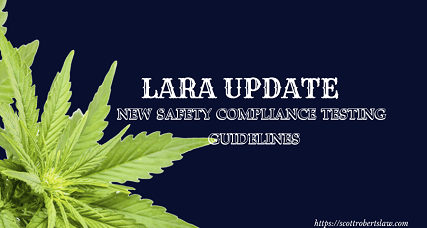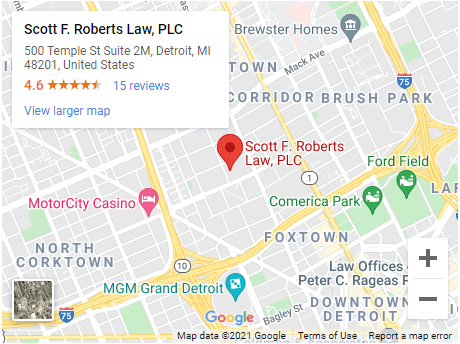LARA recently released new guidelines for safety and compliance testing of marijuana and marijuana infused products. The first thing that jumped off the page in our reading is LARA’s designating this document as a living document. This means that these guidelines can, and likely will, be updated by LARA as the Medical Marijuana program continues to be developed. This article will be a brief summary of the new regulations and the procedures associated with the recently published LARA guidelines.
LARA has broken down each type of testing procedure for different marijuana products and the accepted methods for testing. The testing categories include the following:
- Microbial Pathogens and Total Yeast and Mold,
- Residual Solvent Testing,
- Pesticide Residue Testing,
- Potency Determination,
- Validation Guidelines, and;
- Sampling Guidelines.

The testing methods for each type of procedure is included in the document with a link to the specific method identified. For the sake of keeping this article brief, we will not get into the specifics of what each testing method entails (4-6 methods per testing procedure). We will, however, list the most prevalent sources for accepted testing methods. For the above listed testing procedures that involve testing impurities in marijuana, acceptable methods for testing are coming from the Association of Analytical Communities (AOAC), Food and Drug Administration (FDA), International Standards Organization (ISO), and U.S Department of Agriculture (USDA).
For contaminants in marijuana, LARA seems to be approaching the solution as it would approach preventing contaminated food from spreading. The guidelines do not require testing companies to use all the applicable methods in their testing. However, safety compliance testing centers will be required to use one of the accepted methods, which includes the applicable controls.
For testing of materials, LARA’s focus is on error prevention and pharmaceutical level regulation. The applicable testing methods are coming from the American Society for Testing Materials (ASTM), Environmental Protection Agency (EPA), RESTEK Solvent Method, and U.S Pharmacopeia (USP). These methods tell us that in addition to the testing being regulated more so like traditional instrument testing materials in the pharmaceutical industry, LARA wants to minimize risk of outside contamination from products used in the testing process.
Potency testing gets a bit tricky. Specifically, LARA has required certain methods but also states that they have not been validated to the level of a standard method like the ones above. For this reason, it is likely that this is the segment of LARA’s cannabis testing guidelines most likely to “evolve” with time. This also means potency could be a problem area for testing facilities if the methods are not validated extensively or one of the methods applicable now becomes disfavored later. For current potency testing methods of Cannabis in Michigan, LARA has drawn from the Journal of Chromatography, Analytica Chimica, Cannabis potency and Cannabinoid Profile, and American Herbal Pharmacopoeia. Moreover, since potency testing has not been validated and the validation guidelines are dictated by traditional companies, there may never be an officially validated method for potency testing of Cannabis in Michigan.
SAMPLING GUIDELINES
The guidelines for sampling are not set in stone, as LARA has framed there more as a recommendation or best practice. LARA will require all safety compliance facilities to maintain their own internal standard operating procedures. LARA is requesting these operating procedures be tailored in such a manner that they minimize both imprecision and bias as well as list chronological steps that ensure a consistent and repeatable method.
LARA additionally stipulates that sample sizes must be just large enough to cover the testing requirements. Specifically, this requirement is aimed at preventing any diversion or waste disposal issues. LARA does require a 0.5% of usable marijuana sample size in order to be representative of the group.
COLLECTION PROCEDURES
While LARA has included example collections procedures, it does not require safety compliance facilities to follow those examples. Instead, LARA simply requires that facilities have their own collection procedures. Example collection procedures detailed in the guidelines are Representative sampling, which involves a variety of samples taken from the different types of plants and products produced by a company, and Random Sampling, which is self-explanatory.
LARA also details the different types of equipment and supplies necessary for testing facilities. Most importantly, LARA requires extensive record keeping for licensed safety testing facilities operating within Michigan’s medical marijuana market. The sampling method and results should be recorded and readily accessible. LARA does not require that specific information be used to identify the samples, however, they provided a list for facilities to reference what information could be used.
TESTING PROCEDURES
I do not want to spend too much time fiddling with LARA’s suggested procedures, but there are many valuable tidbits of information in this section. First, LARA will require a 95% confidence level in the accuracy of a licensed safety testing lab’s tests. Second, equipment used for sampling must be certified clean prior to use by a facility. A report is required to demonstrate compliance with certified cleaning.
Third, prior to testing samples, Michigan safety testing facilities need to show an initial demonstration of capability or competency assessment. This showing will have to be repeated with changes in personnel or method. Fourth, internal audit checks and field audits will be necessary to ensure compliance and accuracy. Audits that result in deficiencies will also need to be accompanied by an immediate initiation of corrective action where variances from the procedures are identified or discovered.
REQUIRED TESTING
For required testing, LARA focused this section on limits. Specifically, potency, chemical residues, water activity, solvents, microbiological impurities, and heavy metals. Potency testing is focused on the reporting of THC v. CBD values in the marijuana, as well as an emphasis on the preference of using “as is” values, as oppose to calibrated results based on moisture content.
Chemical residue testing is focused on preventing banned ingredients such as toxic pesticides from making their way into marijuana products. LARA will require a strict adherence to the list and all values must be under the detection limits. A full chart complete with the detection limits for banned products is included in LARA’s most recent guidance. Solvent testing is concerned with the exact same problem except this deals with the use of solvents to produce marijuana products and concentrates such as cannabis extracts, oils and wax. Residual solvents from the concentrate process are listed in a table with their action limits.
Microbiological testing is specifically focused on keeping known pathogens out of marijuana and marijuana products. Additionally, this testing will be required to identify the natural and expected microbes v. the foreign unexpected pathogens. LARA has provided a list that includes water activity and foreign matter tests for identifying the microbes that should be tested for. Michigan outdoor grows may have trouble meeting these requirements due to the fact that it can be difficult to limit microbes and pathogens in an uncontrolled, outdoor environment.
Heavy metal testing is very stringent. LARA requires testing for heavy metals and has a strict denial policy for marijuana that has present in it any of the following: inorganic arsenic, lead, mercury, cadmium, or chromium.
PROFICIENCY AND ACCREDATION
LARA will have a proficiency testing program that will designate the level of proficiency needed to be displayed by safety compliance facilities. It will required at least once annually. The proficiency test will require that Michigan safety compliance facilities have a set of proficiency tests for all tests, within the scope of testing conducted by the facility. Numerical values will have to be presented, as oppose to a pass/fail system. For testing parameters that do not have a proficiency test, another licensed safety testing facility with similar testing methods should perform the same test to confirm the results. LARA will also be conducting unscheduled random testing of matrix matched samples to evaluate the performance of safety compliance facilities.
Scott F. Roberts Law is a boutique Michigan cannabis business law firm representing Michigan medical marijuana licensees, including growers, processors, provisioning centers, secure transporters and safety testing facilities. Contact us today to schedule a free consultation with one of our Michigan cannabis lawyers.




